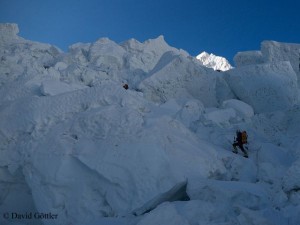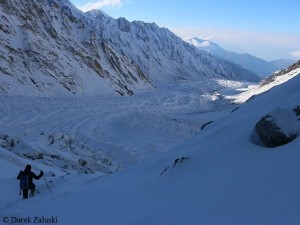Search Results for Tag: Avalanche
Shock and anger on Mount Everest
 “It‘s a tremendous shock to us all“, Dawa Steven Sherpa writes to me from the basecamp on the Nepalese side of Mount Everest. “My team was extremely lucky to miss the avalanche but we have all lost friends and family members in the avalanche.” As in the previous years the 30-year-old Nepalese is leading an “Eco Everest Expedition” which is combining business and ecology: clients are led to the 8850-meter-high summit, but the team is also collecting garbage and brings it down to the valley.
“It‘s a tremendous shock to us all“, Dawa Steven Sherpa writes to me from the basecamp on the Nepalese side of Mount Everest. “My team was extremely lucky to miss the avalanche but we have all lost friends and family members in the avalanche.” As in the previous years the 30-year-old Nepalese is leading an “Eco Everest Expedition” which is combining business and ecology: clients are led to the 8850-meter-high summit, but the team is also collecting garbage and brings it down to the valley.
It is still unclear when the climbing season on Everest will continue – and if at all. Alpine Ascents International (AAI) is the first of the big Everest players that has called off its expedition. “We have all agreed the best thing is to not continue this season’s climb, so that all can mourn the loss of family, friends and comrades in this unprecedented tragedy”, AAI writes on its website. Among the 16 avalanche victims of last Friday were five Sherpas working for AAI. They also supported the U.S. climber Joby Ogwyn, who planned to make the first wingsuit flight from the summit of Everest. Discovery Channel has meanwhile cancelled the live TV broadcast of the jump that was originally planned for 11 May. The team of Adventure Consultants that had lost three members in the avalanche has also decided to go home.
![]() read more
read more
Death trap Khumbu Icefall
The very first climbers had respect for the Khumbu Icefall. This is underlined by the nicknames which the members of the successful British Everest expedition 1953 gave to the risky passages through the labyrinth of ice: “Hillary’s Horror”, “Mike’s Horror”, “Atom Bomb area”. The icefall was “the key to all attempts on the south side of Everest”, wrote Sir Edmund Hillary, the New Zealander, who, together with Sherpa Tenzing Norgay, stood first on the 8850-meter-high summit. Since then about 40 climbers, most of them Sherpas, were killed in the Khumbu Icefall by avalanches from the west shoulder or collapsing seracs. In recent years, high temperatures have even increased the danger of avalanches. For this reason, the New Zealand expedition organizer Russell Brice had abandoned his expedition in 2012.
No hope for missing climbers
The disaster on Friday was the worst in the history of Mount Everest. By now 13 dead bodies have been recovered from the ice and snow. There was no more hope to find the three still missing climbers alive, said a spokesman of the Ministry of Tourism. All victims are Nepalis, most belonged to the ethnic group of Sherpas. They all were carrying material and food from basecamp to the camp above the icefall, when they were hit by the ice avalanche. They had no chance to escape.
![]() read more
read more
At least twelve killed in avalanche on Everest
The spring season on Everest begins with a disaster. On the Nepalese south side of the mountain, an avalanche has hit the Khumbu Icefall. “Around 25 persons were swept away by the avalanche”, a spokesman of the Nepalese Ministry of Tourism said. “We have rescued eight alive, and 12 bodies have been recovered so far.” Four Sherpas were still missing. Climbers from six expeditions were caught in the avalanche. Due to other reports, all victims were Sherpas who were fixing the route route through the labyrinth of ice when the avalanche went off at an altitude of about 5800 meters.
The dangerous passage is called “popcorn field” because there are so many ice blocks of collapsed seracs or out of ice avalanches. This spring, some 300 climbers from 28 expeditions have pitched their tents on the south side of Mount Everest.
By now it is the worst avalanche disaster in the history of Mount Everest. In 1922, on the Tibetan north side of Mount Everest seven Sherpas were killed in an avalanche. In 1970 within days seven Sherpas lost their lives in the Khumbu Icefall.
Avalanche on Nanga Parbat
Dramatic turn on Nanga Parbat: The Polish climbers Pavel Dunaj and Michal Obrycki have been hit by an avalanche when they were about 5000 meters high, just below Camp 1. Both were injured. Explorersweb.com reports that Pavel broke an arm and several ribs. Michal has apparently suffered leg injuries and a broken nose. Tomek Mackiewicz, Jacek Teler and Pakistani helpers succeeded to bring the two injured back to basecamp. They are to be flown out as soon as possible. “Helicopters and pilots are on standby but due to inclement weather conditions the helicopter evacuation has not been possible since yesterday”, informs Muhammad Irfan of the air rescue company “Askari Chartered Services (ACS)” on the Facebook page of the Polish Expedition. “However, we remain standby and as soon as the weather improves the helicopters will be dispatched to evacuate the Polish climbers.” As reported, Dunaj and Obrycki had climbed up to make a new track and to dig out Camp 1. Mackiewicz and Teler wanted to follow on Sunday.
Update 11. March: Pavel and Michal were brought on stretchers to the nearest village Tarashing, from where they should be driven by jeeps to hospital.
Very lucky
Ralf Dujmovits’ concerns were not deceptive. The day after he and his Polish companion Darek Zaluski had decided to cancel their winter expedition on the Diamir side of Nanga Parbat, they narrowly escaped an ice avalanche. The two climbers had just build down their Camp 1 at 4900 meters below the Kinshofer route and were on their descent when the avalanche went down. “We were very lucky!”, Ralf writes to me. The 52-year-old and Darek arrived in basecamp safe and sound. As reported Dujmovits had abandoned his plan to climb Nanga Parbat via the Messner route because of the high risk of ice avalanches.
![]() read more
read more













Feedback